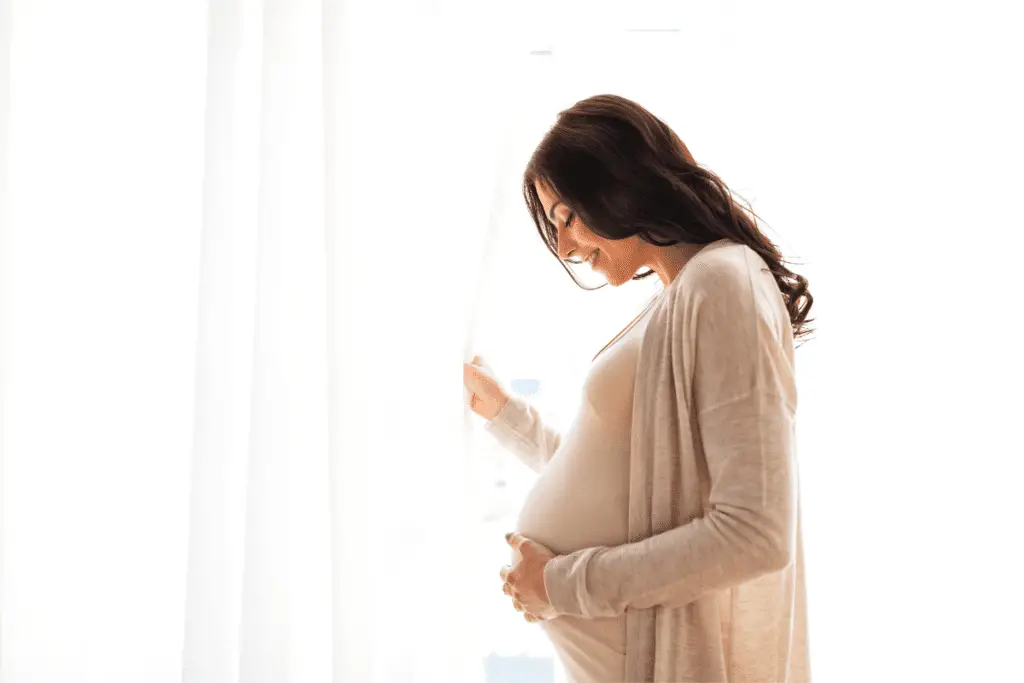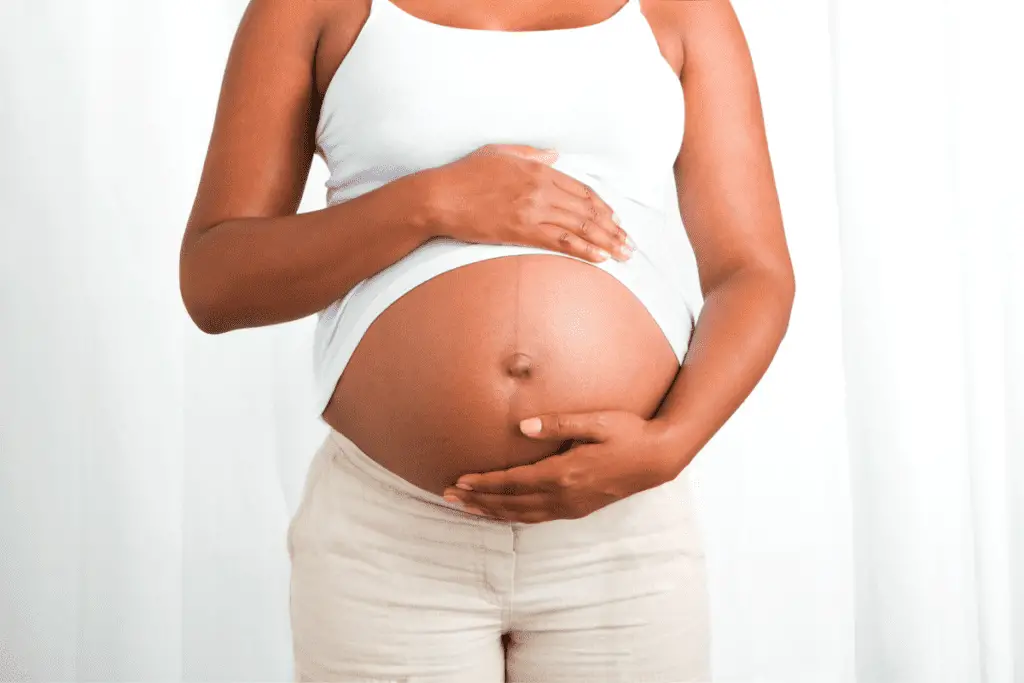Every pregnancy is different. However, there are some very common signs that labor is coming soon.
Besides real contractions, other clear signs that labor is 24-48 hours away are the loss of the usually slightly bloody mucus plug or loss of amniotic fluid. In addition, you might notice rather unspecific changes, by which you can recognize that labor will start within a few hours or days.

Most babies don’t seem to care about their exact due date, and your little one might choose to come a bit sooner or later. Therefore, the last few weeks and days of pregnancy are particularly exciting: When will the big day come? How can you tell that labor is close? And how do you feel in the days before labor?
Let me show you how to recognize your body’s signals and physical signs leading up to labor and how to interpret them correctly:
The 9 most common signs that labor is 24-48 hours away
1. Physical restlessness
Shortly before the start of labor, many pregnant women suddenly feel a burst of energy to do physically demanding tasks like cleaning the whole apartment or re-organize the nursery. It is also called nesting instinct. Usually, women experience it stronger if not everything is quite as prepared as hoped for at that point in pregnancy.
This desire to prepare the home for the baby is a typical sign of the approaching birth. Many times such physical activities can also help to stimulate labor and can be the cause of labor being close that way.
If you are at that stage, here is a list with the only 10 baby items you need to have ready for your little one before giving birth. It will help you to organize the nursery and feel well prepared for the big day of welcoming your baby at home.
2. Exhaustion / extreme fatigue
A feeling of exhaustion and insomnia can also be signs of being close to your baby’s birthday. That is caused by hormonal changes that are triggering labor.
Personally, I felt extreme exhaustion 24 hours before labor with my daughter. Suddenly I was so tired and even started canceling plans I had made for the next few days, feeling like I needed to rest. It was amusing to look back and find out why the day after.
3. Back pain
Back pain a few days before the delivery is also a typical sign that labor is near. The pain feels similar to menstrual pain or worse and is often caused by the uterus doing practice contractions.
4. Nausea and vomiting
At the very beginning of the birth, when labor starts, some pregnant women feel very nauseous, and some even vomit.
5. Diarrhea
The contractions of the uterus and the prostaglandins released by the uterine wall can affect digestion, causing some pregnant women to have very soft stools or even diarrhea shortly before going into labor.
That will benefit the birth process since the baby will have more space.
6. Discharge
By the end of your pregnancy, many pregnant women notice more mucus leakage than before. Viscous, slimy, clear or pink, possibly even slightly bloody discharge can also be caused by the loss of the so-called mucus plug and is a clear sign of labor being a few hours or days away:
7. Loss of mucus plug
The mucus plug is what closes the cervix during pregnancy and prevents germs from entering. When labor is near, the cervix starts expanding or opening, and the mucus plug “falls out.”
The detachment of the plug can happen as early as a few days before the actual birth (rarely even in the 38th week of pregnancy already) and as late as in active labor. So, no reliable statement can be made as to when exactly the birth will start based on the loss of the mucus plug. However, one thing is for sure: the body is getting ready for birth.
If the birth isn’t a woman’s first one, the mucus plug may come off sooner than later because the muscles around the cervix are already a bit looser than they were before any pregnancy.
The color and consistency of the mucus plug vary from transparent and watery to viscous pink and brown. And don’t worry, even if it bleeds a little bit, it’s perfectly normal.
8. Loss of amniotic fluid
When the water breaks (aka the amniotic sac membranes surrounding the baby tear), the pregnant woman starts to lose amniotic fluid.
The loss of amniotic fluid is a sure sign of labor being 24-48 hours away. However, contrary to what is often seen in movies, it often happens when the woman is already in labor. Usually, the pressure of the contractions on the amniotic sac causes the membranes to rupture.
However, every birth is different, and it is also possible that your water breaks before feeling any contractions. In that case, labor will likely start within the next 24 hours. It should actually because once the amniotic sac has burst, some of its protective functions are lost, and the risk of infection increases.
It is important that you contact your midwife or the hospital when experiencing the loss of amniotic fluid so that you can discuss further procedures together.
The amniotic fluid can come out in gush or just drop by drop. Sometimes it’s even hard to know if you are leaking a little pee or if your water really has broken.
How can I tell the difference between amniotic fluid and urine?
If you only lose a few droplets and aren’t sure if it’s amniotic fluid, try to empty your bladder. If it’s still dripping and you can’t control it, it might be amniotic fluid, and your water has broken. However, when in doubt, always contact your provider.
A medical examination in the hospital might be needed to determine whether it is just urine or if your water has broken.

9. Regular contractions which don’t decrease when you rest or take a warm bath
The most obvious sign that labor is starting is “real” contractions. These regular contractions of the uterus ultimately bring the baby into the birth canal and open the cervix enough for the little one to come out.
However, most women already experience the so-called Braxton Hicks contractions from the 32nd week of pregnancy onwards: the uterus is preparing for childbirth with these so-called practice contractions.
How do you know if you have real contractions or just some more Braxton Hicks?
Most pregnant women perceive Braxton Hicks contractions as hardening of the belly without much further pain. They usually occur at irregular intervals. Unlike labor-inducing contractions, they don’t increase in intensity and eventually stop altogether, especially when you lie down or rest.
It’s not always easy to decide whether you are experiencing more Braxton Hicks or if the birth is about to start.
Here are a few little tricks you can use to find out if labor is 24-48 hours away and you are experiencing the beginning of it or if your body is still practicing:
- Take a warm bath
If the contractions ease in warm water and eventually stop altogether, they have not been the real deal. If they continue or even intensify, you are in active labor!
Caution: Don’t try this when you are home alone, just in case you might need assistance if things progress faster than expected.
- Track the time
Check the clock or use an app to measure the time between contractions. It is a clear sign of actual labor if you find them coming at regular intervals every 5-10 minutes and lasting up to 60 seconds.
However, as mentioned before, every birth is different, and what applies to one woman can be entirely different for another. So, if you are unsure whether you are interpreting your body’s signs of birth correctly, always call your midwife or the hospital.

The causes of signs that labor is 24-48 hours away
Like during the whole pregnancy, a lot happens in the woman’s body in the few days before delivery, causing all the symptoms mentioned above. Parallel to all these events, your baby is also very active before birth and is getting ready to come into this world.
Let’s take a look behind the scenes:
What happens in the woman’s body when labor is near?
· The pelvis becomes more and more flexible week by week towards the end of pregnancy.
The pregnancy hormone relaxin ensures that the connections between the bones in the pelvis become softer and, therefore, more flexible. That will make it easier for your baby to enter the world.
· Everything down there also becomes more elastic and loosens the cervix, the tissue of the vagina and the perineum, the pelvic floor, and the birth canal. All of this will make the birth process easier for your child.
· In the last few weeks and days before delivery, the cervix shrinks. At first, it becomes much softer than usual and gradually shortens. Shortly before birth, it will even already begin to open slightly.
What happens with your baby causing signs that labor is approaching?
· Your baby is hopefully taking the head-first position! While your little one has been changing its position in your tummy from time to time until recently, it will now ideally be lying head down. This position enables your baby to slide even deeper into the pelvis over the last few days of pregnancy.
· Your baby absorbs more progesterone from your placenta than ever before in the days leading up to the big event. That is very important for the lung maturation of your little one. As a result, your own progesterone levels will drop, and at the same time, your estrogen levels will rise. With the release of oxytocin, your little one is signaling that it’s finally time to start, and then labor will begin.

Soft signs of approaching birth
The first six signs that labor is 24-48 hours away mentioned above are also called soft signs of labor being near. They vary in intensity from woman to woman, and some pregnant women do not experience them at all.
It is not really possible to determine when and if these signs start appearing during pregnancy. So, experiencing them doesn’t give you a guarantee that labor is 24-48 hours away. However, they do tell you that you are approaching the end of your pregnancy soon.
Soft signs labor is near:
· Physical restlessness
· Exhaustion / extreme fatigue
· Back pain
· Nausea and vomiting
· Diarrhoea
· Discharge
Simply see these signs as a signal that your pregnancy is slowly but surely coming to an end. Observe your body closely and give yourself as much rest as possible.

How to know for sure that labor is 24 to 48 hours away
The three signs that are sure signs of labor being close are:
· Loss of mucus plug
· Loss of amniotic fluid
· Regular contractions which don’t decrease when you rest or take a warm bath
When experiencing those, you are about to meet your baby very soon! Get ready and trust your body and baby. You got this, momma!

What happens if there are still no signs of birth after the 40th week of pregnancy?
Only about 4% of all babies are born on their due date. Most are born within 14 days before or after. With a normal course of pregnancy, there is no need to worry if you do not feel any signs of birth in the 40th week of pregnancy yet. You will be examined regularly so that any risk can be ruled out. Talk to your provider and try these 9 ways to induce labor naturally at home.
When to go to the hospital?
When experiencing labor pains and symptoms of labor being 24-48 hours away, it is always right to contact your midwife or provider. He or she will tell you whether you can stay at home or whether you should slowly make your way to the hospital.
As a rule of thumb, if you are giving birth for the first time, the contractions should occur regularly every ten minutes before going in. However, if you are a second-time mom or more, you might be advised differently since birth might progress faster.
Do you have your hospital bag packed already? Get your free checklist here to make sure you haven’t forgotten anything!

